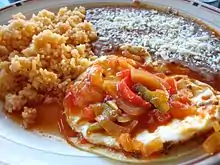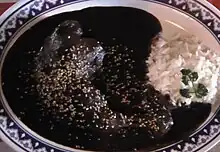.jpg.webp)
Esquites (or ezquites) (troles and trolelotes in Northeast Mexico, chasca in Aguascalientes, vasolote in Michoacán, etc.) also known as elote en vaso (corn in a cup), also served in the Southwestern USA[1][2][3][4] is a Mexican snack or antojito.[5] One can find them at local markets, and street vendors selling corn. The word esquites comes from the Nahuatl word ízquitl, which means "toasted corn".[6]

Origin
Although its true origin is not known, it is a common understanding that esquites are historically a common Mexican street food. According to Nahuatl stories, esquites are credited as being created by the deity Tlazocihuapilli of Xochimilcas, who is also credited with creating Mexican Atole and corn jelly.[7][8]
There is an alternative origin story that claims that in the late 1800's, Emperor Maxamilion and Empress Carlota created a dish referred to as "Odalisque Teeth", when they accidentally used corn flour instead of wheat.[9] The modern day esquite is known as a Mestizo preparation because many of its fundamental ingredients (not including corn) were from Spain. [10]
Ingredients


Esquites are generally made from white corn kernels that have been boiled and softened in water, which typically contains salt and epazote. Sometimes the corn is also sauteed in butter and onions after it has been boiled. The white corn kernels are first boiled until soft and tender in large pots and served in plastic or styrofoam cups, hence the name in English, "corn in cup". One can additionally find them being served in corn husks. The ingredients can vary; toppings for esquites include (but are not limited to) combinations of lime juice, chili powder or hot sauce, salt, cotija cheese, and mayonnaise.[11][12] In places like Mexico City they are also topped with Mexican Chapulines or crickets.
A popular modern-day variation is to top the corn with blended Flamin' Hot Cheetos or Takis. New Variations include all the same ingredients but mixed in with a chip bag of choice.
See also
References
- ↑ "La Elotería". Archived from the original on 2015-12-08. Retrieved 2015-12-02.
- ↑ "Vaso de Elotes Saludable > Bocadillos | Unilever Food Solutions México". Dec 8, 2015. Archived from the original on December 8, 2015. Retrieved Dec 2, 2019.
- ↑ "Recetas de elote en vaso". myTaste.mx. Retrieved 29 May 2018.
- ↑ "Elote en vaso del Centro Histórico | Bonito León Guanajuato". Archived from the original on 2015-12-08. Retrieved 2015-12-02.
- ↑ "Elotes y esquites para quitar el antojo". TV Azteca (in Spanish). Archived from the original on 2010-03-24. Retrieved 2010-09-25.
- ↑ Gonzalez, Dommy. "Street Food: Welcome to the Season of Esquites: Mexican Grilled Corn". LA Weekly. Archived from the original on 2010-08-19. Retrieved 2010-09-25.
- ↑ Sam, Vanessa; Rebolledo, Christian Valera (2021-01-06). "Mexican Esquites Give a Tasty Twist to Corn". Zenger News. Retrieved 2022-05-04.
- ↑ Amigofoods (2021-03-05). "Esquites, Mexican Corn In A Cup". The Best Latin & Spanish Food Articles & Recipes - Amigofoods. Retrieved 2022-05-04.
- ↑ Amigofoods (2021-03-05). "Esquites, Mexican Corn In A Cup". The Best Latin & Spanish Food Articles & Recipes - Amigofoods. Retrieved 2022-05-04.
- ↑ "Esquites, the most popular corn craving in Mexico". Mexicanist. 2021-10-27. Retrieved 2022-05-04.
- ↑ Patronite, Rob; Raisfeld, Robin. "The Esquites Man". New York. Retrieved 2010-09-25.
- ↑ Cardona, Gloria (2007-09-01). Esquites (in Spanish). Editorial Pax México. ISBN 978-968-860-836-4. Retrieved 2010-09-24.
{{cite book}}:|work=ignored (help)




.jpg.webp)




_01.JPG.webp)
